Living here in the Sunshine State, it seems that folks have an unusual penchant for $0.69 sq. ft. 20″ tiles. The most popular colors are blah, boring, and blech. People love to toss these tiles down over red oak, irreplaceable heart pine, and any number of historic floors.
These tiles are spreading like a wildfire across the floors of historic homes. Something must be done! Which brings us to our number 2 worst mistake of historic homeowners…
Flooring
Historic houses are having their floors covered up, ripped out, or trashed in any number of ways to make room for newer, inferior products. Only in America would we be ignorant enough to cover what would be a $15 or $20 per sq. ft. floor with a $.50 per sq. ft. floor. Are we really that shallow? Historic homes have some of the finest flooring available. Have you ever seen a 70 year old vinyl floor? I didn’t think so. How about laminate flooring that has made it even 30 years? Me neither.
Todays floors, even the top quality ones, come with 25 and even 40 year warranties which isn’t too bad, but why would you replace a floor that will last centuries with one that lasts only a third that long?
And in today’s real estate market, most of us are being ever mindful of home values. The typical buyer of an old or historic home is expecting hardwood floors. “Maintenance-free” tile is not a selling point for these kind of houses. And while a click-lock engineered wood or laminate floor may be considered an upgrade on a new home, it is a definite cold shower to your historic home’s market price. The jura hausarbeit ghostwriter shared one fact with me. Some homeowners, when selling a historic home, enter into a legal contract where they describe that the floor cannot be replaced because it is historic property.
Wood Floor Restoration
Wood floors are prime candidates for refinishing and restoration. If you have pet stains, loose/missing boards, rot, termite damage, or other issues, these are simple repairs for a flooring professional. And if you get someone who says your floors aren’t repairable, they are most likely either too lazy to do the work or trying to sell you new floors. Either way, RUN! I have yet to come across a solid wood floor that couldn’t be repaired. The same is almost never true for tile, laminate, vinyl or even engineered wood floors.
Probably one of my favorite jobs restoring a floor was this 1920s heart pine I came across. The home had been used as a business for a time and apparently there had been some damage to the original floors that was patched…well, let’s just say poorly, and then carpeted over. When the new homeowner found the damage she intended to tile over the entire house with the afore mentioned tile.
I was referred to her when her tiling was about halfway done and convinced her (read: begged) her to save the remaining floors because they were not beyond repair. A week later after replacement boards were installed and the floors were refinished, she had what looked like new floors!
Solid wood flooring, like this, found in most historic homes is extremely resilient. It can handle multiple refinishings (done properly) over its life and is easy to repair in a way that is almost certainly unnoticeable. And what’s best is that it can last hundreds of years with minimal care!
So, before you jump to “upgrade” the flooring in your historic home, take a minute and think it over. Do you want a different color? Stain it. A different glossiness? Refinish it. You can even paint your wood floor to look like almost anything. The only boundaries are your own imagination. And if you are wondering if your floor can be repaired, the answer is almost always “Yes!” Search around for a hardwood refinishing specialist or restoration company and you will find someone up to the task of rejuvenating your floors. And trust me, it will be worth it!
Tired of the same old wood floors? You can make quite a statement with some stain or paint. I’ve included some fun ideas of what others have done with their hardwood floors. Get creative!
You can also learn more about the history of hardwood floors in our post A History of Wood Floors
Read the rest of the 5 Worst Mistakes of Historic Homeowners:

Founder & Editor-in-Chief
I love old houses, working with my hands, and teaching others the excitment of doing it yourself! Everything is teachable if you only give it the chance.

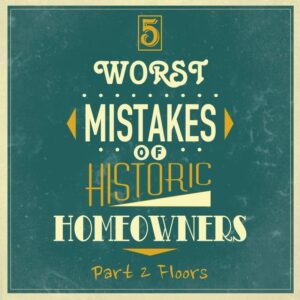
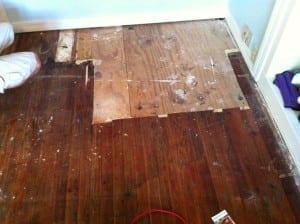
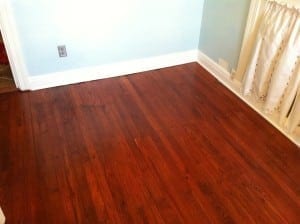
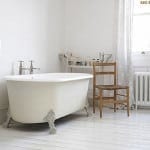


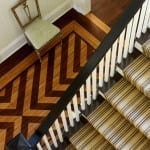
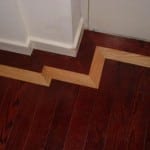
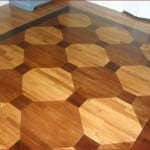


We are building a new cabin in the Pacific Northwest near Mt Hood. We pulled the fir flooring out of the original cabin built in 1940’s that was neglected and the foundation was destroyed by a flood 4 years ago. The fir was not finished so it is bare. We found heaps of fine dust under some of the boards. We didn’t keep those because we are quite sure it is Powder beetle. Should we treat with Borax product or just starts over with new flooring?
Linda, to protect yourselves I would go ahead and treat all the wood with BoraCare that way you can reuse everything that is still sound and not worry about insects.
Our floors are original hardwood from the 1920s. It just has a polyurethane stain on it so it is the woods natural color. We are trying to stain new heart of pine to match the old. Any suggestions on how to match the new stain with the old stain?
Just test a few similar stain colors on sample boards and see what gets you closest. It’s usually trial and error even for the pros.
Our home was built in 1894 and still has the original wood floors…some covered and some exposed. It needs completly refinished. We can do the work ourselves, just wondering what the cost would be like to restore a 1600 square foot home (floors) the wood kinda has spaces between the slats…can that be filled in?
Some gaps can be filled and refinishing usually runs about $2.50 to $3.25 per square foot.
Scott, great site! I just purchased a house that was built in 1880. I pulled back the grubby carpet today to find pine floors on the second floor. They look pretty filthy and tired. I cannot wait to have them refinished! I’m sure they will clean up nicely. Thanks for all the encouragement to keep these old gems alive with pride.
Congrats Justin! Good luck with the new old house!
Hi, we had century old knotty heart pine floors installed on our first floor. We wanted the natural look and decided not to stain but just used 1 coat of minwax with a light brown tone to seal. However we are noticing, especially in kitchen, lots of spots and stains. What should we do?
Thanks.
We’ve been re-finishing the red-oak floors room by room since we moved into our ’30s home several years ago, and finally got to the kitchen. The kitchen had a couple of rough patches, and the previous owner had painted it. As part of our kitchen renovation, I stripped it down to bare wood and discovered that this one room is actually done with heart pine. Aside from the water stains which I’m hoping to address with oxalic acid – it’s in pretty good shape and the wood is beautiful. What I’m struggling with now is what to do next. I expect the pine will take stain differently than the adjacent oak has, so trying to carry the same cherry stain into the kitchen seems like a bad idea. I think I’d prefer to the kitchen to be unique anyway. Any thoughts or tips on using different woods with different stain selections in adjacent rooms?
I am bumfuzzled. I love my old farmhouse built in 1929 and want to do some remodeling which of course will have priorities. The floor is wood and I think it is pine or fir. My problem is there is NO insulation or anything underneath but the 3-4 feet between the pin/fir and the dirt on this old pier and beam. I also have four dogs. I found some pet friendly flooring that has cork and filler then vinyl that looks pretty good but I love the real wood. I tried putting some linseed oil on after a good pinesol cleaning but it just sucked it up and made it a little bit darker there is no kind of finish just a funky patina fo many paint overs. Any suggestions would be helpful 🙁
I have a 1915 craftsman cottage style home and the floors are unsealed wormy chestnut. What is the best way to rejuvenate them without putting “poly” on them. I damp mop them, but they seem to be drying out. What is the best product to clean them and make them shine? Thanks!
For unsealed floors I would probably use boiled linseed oil and a wax or just wax.
I have a home built in 1825, but the kids’ bathroom is probably from 1910 or so. It has fir floors. We are renovating the bath and the contractor is encouraging me to tile the floors. Should I do it to prevent water damage? I am hesitant to cover these beautiful floors.
If the floors are still beautiful after 105 years and you love them that much I would venture to say that you would be a responsible enough homeowner to protect them from standing water. I say if you like the floors and they’re in good shape then there is no reason you should tile over it.
I’m not sure how old my house is , only that it is an old farm house that was ripped apart numerous times by numerous previous owners -so sad- but the beautiful wide pine floors have withstood the attack.
they are really fabulous – but have needed some help
Wondering what to do about door sills between the rooms
i would be great full for any suggestion
Thanks Charlene
This series has been very helpful. Just one question. We have an old 1901 house and are installing new red oak flooring and replacing the depression wood. Should pocket door jams be cut to allow the new boards to slide under or should contractor cut boards to form around door jam. Contracter doesn’t want to cut jams because they are old and might be brittle. Problem is there is a small space between the boards and jam that will need to be puttied. Will this look ok?
Bob, the jambs should definitely be cut to allow the flooring to slide underneath. I do it often and haven’t found anything too brittle or old that it can’t be cut with a proper saw. Honestly sounds like laziness on the contractor’s part.
I recently replaced repair my 1.5″ red oak floor after removing a few cast iron radiators. After sanding a few of the old boards down to bare wood they are noticeably darker than the new planks I installed. My plan is to polyurethane the entire floor. Should I stain the floor or do you have another suggestion? I would like to get as close to the natural finish as possible.
Hi! My husband and I have a bungalow/cape cod hybrid home built in 1941 with original EVERYTHING…wood floors, gorgeous vitrolite tile in the bathrooms and kitchen, light fixtures, appliances…all original. The previous owners had pets that left horrible large black stains on our wood flooring. I want to refinish/restore them, but my husband says it’s no use and wants to put carpet down. Can the black stains be removed or lightened, and if not, would a dark espresso-type stain color camouflage them? I don’t want to lose the character of the wood floors to bland carpet.
Thanks!
Coley, I would try refinishing the floors first. Once they are sanded you can try using oxalic acid on pets stains and that usually significantly lightens them or sometime completely removes them. Also, you’re right that a dark stain will help hide the stains. I say keep them!
We just bought a 1930 Bungalow and got down to the wood floors. In the bedroom they are really raw, but still good tong and groove. The second bedroom has some missing pieces and a lot of liquid damage of some sort, smells like cats were there. Is there anything that can take out that odor, as we really want to keep the floors. Tile is in the rest and will come up next year sometime.
Try oxalic acid on the pet stains. It doesn’t always work, but I have had success with it in the past. Try it in an out of the way area first to test how it will work on your floors.
I recently purchased house built in late 60’s, early 70’s that appeared to have hardwood flooring thru out (which I am almost positive because everything else in house is original pink baths, harvest gold appliances, etc). I started to make a repair at sliding door and behold it appears that this is some type of old veneer wood, maybe 5/15-3/8 thick. Decent shape overall, but lot of finish worn off. didn’t know they used anything but 3/4 t&g back then. Any ideas on what this was, can it be refinished, and how to fix rotted pcs. Approx 1500sf of this, hate to tear it all out, and certainly wreck my restoration budget. Thanks for any insight.
Ted, veneer and engineered wood floors were coming into use in that period. It’s not really my forte, but you will likely have a decent challenge trying to find an exact match. If the wear layer on top is thick enough you may be able to refinish them though.
Hello, I just bought a craftsman style house with dark trim throughout. The previous owners have put down qs white oak flooring that I am refinishing. Any suggestions about stain colours that would compliment the stained red oak trim? I want to go as light as possible. What’s there now doesn’t look quite right.
Thanks and I love your blog.
Peter
Hello
I’m in the middle of a kitchen renovation of our 1933 house. Under several layers of plywood and linoleum there is the original white oak floor. Same floor that is elsewhere in the house, only it’s dark and has gaps. Turns out the plywood was nailed down in a pattern of a nail every 6 inches one way and every 3 inches the other way. Some water damage too. A flooring specialist already came to see it and said you would see the nail holes after restoration, but he could do refinish if I was ok with that. i’m wondering, after checking some reclaimed floor websites, if the nail holes might add character? On the other hand, the regularity of the nail pattern bothers me a little. What if some boards get replaced, where there is water damage or other damage and that way the regularity is disrupted? Another question is how do deal with the nail holes? Checking out reclaimed flooring sites, it appears in the reclaimed floors they never mask imperfections, they might even accentuate them. If not wood putty or another filler how would you deal with the nail holes?
Many thanks, this is a great site.
Angela
We recently purchased a 1913 Craftsman Bungalow. At some point the hallway floor access to the crawl space had been nailed shut. This is a high crime area, in a historic district that is still in its way up (hence the good buy!)
Having already had one break-in, Police alerted us to interior crawlspace access is also an access point IN for criminals.
I would love to have this access ability restored so I can access the furnace pilot and plumbing at some point.
Of course, my husband wants to keep it sealed and nailed shut.
How do I restore the accessibility but ensure our family’s safety?
I can provide photos if you email me.
Thank you for this blog. We are debating replacing our fir floors in a 1911 heritage home. A reputable flooring contractor has told us the boards are too thin–and the gouging so widespread (it’s very bad)–that refinishing is not an option. Replacement is the way to go.
How do you really know if floors are too far gone?
And one other question if I may: if we want to paint the floors, is there a good material to fill in the broad and shallow gouges, like those made for example by people sliding the fridge in and out and in and out over the past 100 years? We’re talking wide, sometimes board-width gouges.
Thank yoU!
I have the exact same problem: 1910-1915 fir floors that have been sanded to much in the past–the tongue/groove part was flaking/splintering up in several place. We ended up lightly sanding (not with drum) and gluing down cracking edges and filled in the gaps that were occurring. We did all this DIY. Then we decided to get it stained and coated more quickly than we could due given family/work circumstances; however, the reputable contractor told us not to waste the time or money because the edges even if coated proper would start to splinter up again. He wanted us just to cover up the floor with engineered flooring. What should I do? What did you all end up doing?
I have unearthed original 91 year old fir floors. They have been sanded and stained, but wondering how many coats of poly to put on?
3 full coats of oil-based poly or 4 coats of water-based.
We own a 2 story Queen Ann style home built in 1912.
The main floor has 3 different types of wood flooring and 2 large patched areas–kitchen/dining/office.
I absolutely hate the idea of ripping out these old floors and had planned on having them refinished but my hardwood floor refinisher guy suggested I just run new hardwood thru the main floor so it flows better.
Will this ruin my home value if I remove the original floors?
Renae, I don’t think it would ruin your home value, but I almost always prefer to keep the original if possible. A new floor may flow better through the house and in the end look better but it’s hard to tell without seeing it. It can almost always be repaired if you have the desire.